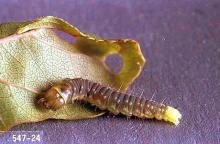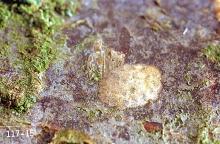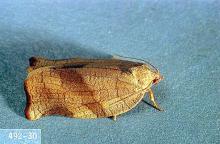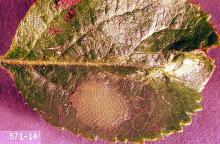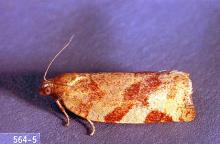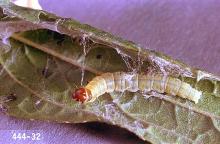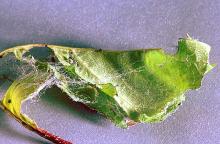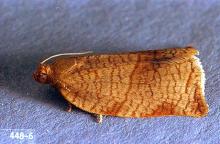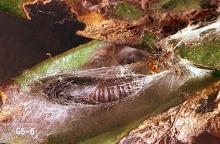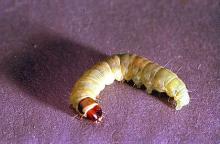Includes
European or filbert leafroller (Archips rosana)
Fruittree leafroller (Archips argyrospila)
Obliquebanded leafroller (Choristoneura rosceana)
Pandemis leafroller (Pandemis pyrusana)
Pest description and crop damage Several species of leafrollers [family: Tortricidae] are pests of tree fruits. These species use native host plants as well as fruit trees. The different species of leafroller cause similar damage to apple trees but differ in appearance and life cycle. The principal leafroller pests of fruit trees are divided into single-generation moths, such as the fruittree leafroller and the European leafroller, and two-generation moths, such as the obliquebanded leafroller and the pandemis leafroller. Adults of these species vary from fawn-color to dark brown. There are distinctive bands or mottling on the wings. Wingspans range from 0.5 to 1 inch. Larvae of these species are all green caterpillars with a light brown to black head, depending on the species. Pandemis larvae are green with a green or brown head. Obliquebanded leafroller larvae are similar to pandemis larvae, except the head is dark brown to black.
As the name leafroller implies, the larvae roll and tie leaves together for shelter and feeding. They thrash about violently when disturbed and may drop from the leaf suspended by a silken thread. Feeding on growing points on young plants can promote undesirable branching. Prebloom leafroller feeding within the cluster results in fruit abortion or deeply scarred fruit. Young larvae are tiny and notoriously difficult to sample, but they are typically most damaging because of feeding on developing fruitlets. The later life stages are evident as the caterpillars reach maximum size and the number of damaged leaves increases. Mature leafroller larvae often move to a new leaf just prior to pupation. By this point, any damage to fruit is complete and it is better to allow natural enemies to reproduce on the mature larvae than to attempt treating the population.
Biology and life history The single-generation leafrollers overwinter as egg masses on twigs and branches. Eggs hatch in spring as buds are opening until petal fall. The larvae feed for 4 to 6 weeks, then pupate in the rolled leaves and emerge as moths in early summer. The overwintering eggs are laid in July.
Two-generation leafrollers overwinter as immature larvae under the bark on scaffold branches of a variety of host plants. Larvae may feed during warm periods in winter but become active in spring with onset of new growth. They feed for several weeks, first on buds then leaves before they pupate in rolled leaves. Adult moths emerge in late April to May. These lay eggs for the next generation. The second generation hatches in early summer and does the most damage.
Scouting and thresholds Scouting for young larvae is challenging, but mature larvae are readily apparent. Populations can be detected early in the season by opening buds around bud break to examine for silk, frass, and minute larvae using magnification. Observe early spring growth for rolled leaves and feeding damage on new growth.
Management-biological control
Very low temperatures in winter significantly reduce overwintering populations of larvae. Spiders and parasitic wasps, as well as predators like the brown lacewing, greatly reduce leafroller populations throughout the year. Parasitism is particularly intense on mature larvae just prior to pupation, a time when insecticide treatments are not effective against leafrollers, but have a strong negative effect on the natural enemy community. A large complex of predators, parasitoid wasps, and parasitoid flies (Tachinidae) attack leafroller larvae.
Management-cultural control
Fruit thinning can reduce problems significantly with some leafrollers. Thin fruit clusters to a single fruit. Hand-pick rolled leaves containing larvae or pupae.
Management-chemical control: HOME USE
Stages 2-3: Delayed-dormant spray
Apply sprays during dormant or delayed-dormant period (March to April). Do not use after pink appears in buds. Use enough water to cover all of the tree thoroughly including small limbs and shoots.
- horticultural mineral oil
Stages 3-4: Prepink & tight cluster sprays, Stages 5-6: Pink spray, and petal fall
- azadirachtin (neem oil)-Some formulations are OMRI-listed for organic use.
- Bacillus thuringiensis var. kurstaki (Btk)-Some formulations are OMRI-listed for organic use.
- carbaryl-Highly toxic to bees.
- esfenvalerate-Highly toxic to bees.
- gamma-cyhalothrin-Highly toxic to bees.
- kaolin-Applied as a spray to leaves, stems, and fruit, it acts as a repellant to target pests. Some formulations are OMRI-listed for organic use.
- lambda-cyhalothrin-Highly toxic to bees.
- permethrin-Highly toxic to bees.
- plant-derived essential oils-Some have shown efficacy against leafrollers. Some formulations are OMRI-listed for organic use.
- pyrethrins (often as a mix with other ingredients)-Some formulations are OMRI-listed for organic use. -Highly toxic to bees.
- spinosad-Some formulations are OMRI-listed for organic use.
- zeta cypermethrin-Highly toxic to bees.
Management-chemical control: COMMERCIAL USE
Stages 2-3: Delayed-dormant spray
- pyriproxyfen (Esteem 35WP) at 4 to 5 oz/A in up to 400 gal water. Do not exceed two applications per season. Do not apply earlier than 14 days after last Esteem 35 WP IGR treatment. REI 12 hr. [Group 7C]
Stages 3-4: Prepink & tight cluster sprays
- Bacillus thuringiensis var. kurstaki (Btk) (Dipel DF, Javelin, etc.)-Formulations vary; see label for rates. Apply Btk materials two to three times, beginning at prepink, repeating at pink and petal fall. Apply Btk only when temperature exceeds 60°F. REI 4 hr. Some formulations are OMRI-listed for organic use. [Group 11] [larvicide]
- methoxyfenozide (Intrepid 2F) at 8 to 16 fl oz/A in up 100 gal water per application. Apply once or twice against overwintering larvae. Do not exceed 64 fl oz/A per growing season. REI 4 hr. [Group 18]
- peptide GS-omega/kappa-Hxtx-Hv1a (Spear-Lep) at 1 to 2 pints/A. Biological insecticide that should be tank mixed with equal parts of Bt. PHI 0 days. REI 4 hr.
- spinetoram (Delegate WG) at 4.5 to 7 oz/A in up to 100 gal water per application. Do not exceed four applications growing season. REI 4 hr. [Group 5]
- spinosad (Entrust 80WP) at 2 to 3 oz /A in up to 100 gal water per application. Do not exceed 9 oz /A per season. REI 4 hr. [Group 5] larvicidal] OMRI-listed for organic use.
Stages 5-6: Pink spray
- Bacillus thuringiensis var. kurstaki (Btk) (Dipel, Javelin, etc.)-Formulations vary; see label for rates. Apply Btk materials two to three times, beginning at prepink, repeating at pink and petal fall. Apply Btk when temperature exceeds 60°F. REI 4 hr. Some formulations are OMRI-listed for organic use. [Group 11] [larvicide]
- fenpropathrin (Danitol 2.4 EC) at 16 fl oz/A in up to 100 gal per application. Do not exceed 42.7 fl oz/A per season. REI 24 hr. [Group 3]
- methoxyfenozide (Intrepid 2F) at 8 to 16 fl oz/A in up to 100 gal water per application. Apply once or twice against overwintering larvae. Use adjuvant. Do not exceed 64 fl oz/A. REI 4 hr. [Group 18]
- peptide GS-omega/kappa-Hxtx-Hv1a (Spear-Lep) at 1 to 2 pints/A. Biological insecticide that should be tank mixed with equal parts of Bt. PHI 0 days. REI 4 hr.
- pyriproxyfen (Esteem 35WP) at 4 to 5 oz/A in up to 100 gal water per application. Do not exceed two applications per growing season. REI 12 hr. [Group 7C]
- spinetoram (Delegate WG) at 4.5 to 7 oz/A in up to 100 gal water per application. Do not exceed four applications per growing season. REI 4 hr. [Group 5]
- spinosad (Entrust 80WP) at 2 to 3 oz/A in up to 100 gal water per application. Do not exceed three applications or 9 oz/A per growing season. REI 4 hr. [Group 5] OMRI-listed for organic use.
Petal fall
- Bacillus thuringiensis var. kurstaki (Btk) (Dipel, Javelin, etc.)-Formulations vary; see label for rates. Apply Btk materials two to three times, beginning at prepink, repeating at pink and petal fall. Apply Btk when temperature exceeds 60°F. REI/PHI 4 hr. Some formulations are OMRI-listed for organic use. [Group 11] [larvicide]
- chloranthraniliprole (Altacor) at 2.5 to 4.5 oz/A in no less than 100 gal water per application. Do not apply more than 9 oz/A per growing season. Do not use an adjuvant within 60 days of harvest. REI 4 hr. PHI 5 days. [Group 28] [ovicide]
- cyantraniliprole (Exirel) at 10 to 17 fl oz/A in up to 100 gal water per application. For overwintering leafroller larvae, apply at pink to petal fall. For summer generations apply ahead of egg hatch. REI 12 hr. PHI 3 days. [Group 28]
- Chromobacterium subtsugae (Grandevo) at 1 to 3 lb/A. Under heavy pest populations, apply a knockdown insecticide prior to or in a tank mix, use the higher label rates, shorten the spray interval, and/or increase the spray volume to improve coverage. REI 4 hr. PHI 0 day. OMRI-listed for organic use.
- emamectin benzoate (Proclaim 5SG) at 3.2 to 4.8 oz/A in up to 100 gal water per application. Do not exceed 14.4 oz/A per season. REI 12 hr (48 hr for workers performing propping, pruning, thinning and tying). PHI 14 days. [Group 6] [larvicide].
- methoxyfenozide (Intrepid 2F) at 8 to 16 fl oz/A in up to 100 gal water per application. Apply once or twice against overwintering larvae. Use adjuvant; see label. Do not exceed 64 fl oz/A per season. REI 4 hr. PHI 14 days. [Group 18] [ovicide]
- novaluron (Rimon) at 30 to 50 fl oz/A in 100 gal water per application. Do not use Rimon in alternate row middle application patterns since this method will result in off-timing application and poor performance. Do not apply more than four applications or more than 150 fl oz/A per growing season. Do not allow Rimon to drift on grapes as leaf spotting may occur. REI 12 hr. PHI 14 days. [Group 15] [ovicide]
- peptide GS-omega/kappa-Hxtx-Hv1a (Spear-Lep) at 1 to 2 pints/A. Biological insecticide that should be tank mixed with equal parts of Bt. PHI 0 days. REI 4 hr.
- pyriproxyfen (Esteem 35WP) at 4 to 5 oz/A in up to 100 gal water per application. Do not exceed two applications per growing season. REI 12 hr. PHI 45 days. [Group 7C]
- spinetoram (Delegate WG) at 4.5 to 7 oz/A in up to 100 gal water per application. Do not exceed four applications per growing season. REI 4 hr. PHI 7 days. [Group 5]
- spinosad (Entrust 80WP) at 2 to 3 oz/A in up to 100 gal water per application. Do not exceed three applications or 9 oz/A per growing season. REI 4 hr. PHI 7 days [Group 5] [larvicide] OMRI-listed.
Resistance management Leafrollers can develop resistance rapidly to chemical controls. Alternate chemistries and modes of action.

